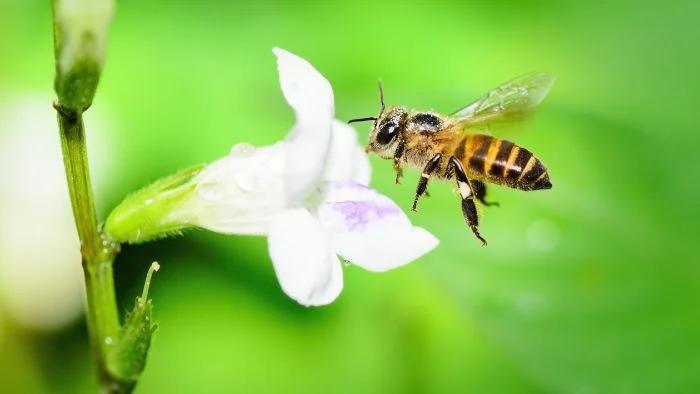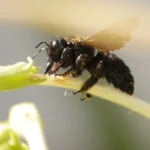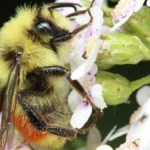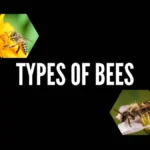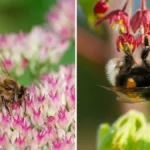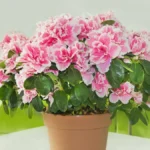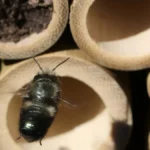As more of us learn how important native bees are, you may be wondering about Californian native bees identification tips. Native bees are excellent pollinators, and if you can identify them, you can also work out what accommodation to place around your garden to keep them happy and keep your garden healthy. Native bees are very unlikely to sting and are excellent beautiful pollinators. Read on to find out how to identify and encourage your local bee biodiversity.
What Are Native Bees?
We all probably know that there are honeybees, and maybe bumblebees. However the honeybee is not native to North America – it is an exotic invasive species introduced from Europe and Africa. Many species of bumblebees have also been moved around the world; in some cases, these become invasive too.
Native bees are the original bees that were found in your area before the introduction of honeybees and exotic or extralimital bumble bees. Extralimital bumble bees would be for instance if we moved a bee from the East Coast to the West Coast. Although the bee is indigenous to the East Coast, and by definition, therefore indigenous to the USA, moving it to the west coast is exactly the same as moving a bee from one country to another. The bees can become invasives in an ecosystem to which they are not adapted.
In this regard, when we are looking at Native Bees, my favorites are the Mason bees that build mud nests, the leaf cutters that make nests out of leaves, carpenter bees that burrow into trees and nest in holes, and of course bumble bees that make their little honeypots in hidden places and have a semi-social nature.
Let’s have a look at a few examples of easy cases for Californian native bees identification.
Types Of Native Bees In California
Common Carpenter Bees of California
I love carpenter bees. They are actually my favorite pollinators, despite me being a beekeeper and naturally having a loyalty to my honeybees. Carpenter bees range in size from large to huge! The huge carpenter bees just land on a flower and it is like a big helicopter just landing on a field. It blows pollen all over the place.
After mating in spring, female carpenter bees, as part of their lifecycle burrow into wood and porous materials. They lay their eggs in balls of pollen and nectar, then make a wall, lay another pollen ball with an egg, and so on. The following year in spring, the larvae have matured into adults, and emerge and the process continues.
If you provide a nesting site such as this one you provide a range of options and will get carpenter bees nesting, along with other native bees. If you use a nesting site such as this one you will find you may nest mainly carpenter bees. If you look at the blurb for the product it says you will attract all sorts of bees, including honeybees!! There is no way a honeybee will ever go there, so discount the marketing material and trust my experience that that will really work for carpenter bees mainly. Let’s have a peek at who you may expect to get nesting in your carpenter bee habitats.


Xylocopa Californica
I thought I would start with Xylocopids, just because these are my favorite bee type. Xylocopa californica is a pitch-black bee with a slight greeny blue color to the body. I first saw these in the Palo Duro Canyon in Texas once, and have loved this bee ever since. It has a curious habit of starting the day very early, and as the temperature gets higher it will go and hide somewhere. This is an excellent pollinator in hot dry areas, and I am sure as the world gets warmer in the next few decades, centuries, and millennia it will become a more and more important pollinator in the increasingly dry and arid climate of much of North America.
This bee is by far the biggest native bee in California. Basically, if you see a pitch-black bee that is an inch or more long, and has a slight green tint to it when in bright light, you have seen this beautiful giant pollinator!
Common Native Bumble Bees Of California

The Yellow-Faced Bumble Bee – Bombus vosnesenskii
This bumble bee is probably the most commonly sighted bee in California after the honeybee. The honeybee is not native to California, but the Yellow Faced Bumble Bee is. The Yellow Faced Bumble bee has filled a niche in the West Coast ecosystem left by the decimation of the Western Bumble bee by nosema disease. This resilient bumble bee performs ecosystem services in the form of pollination of both indigenous plants and exotic cultivated plants that have been introduced to the west coast for agriculture. The bumble bee forms ground nests of up to 300 or more bees and starts its season very early.
The Yellow-Faced Bumble bee is quite a large bee and starts its season early. Queens emerge from their hiding places in spring and start a nest foraging and feeding the first eggs that are laid – these become the first workers. As the colony increases, the workers feed the queen and larvae more and more, and then towards the end of the season, the queen begins to forage and feed the remaining brood. As the colony collapses in autumn young queens go out to find places to hide during the winter, and will then emerge in spring and start the process over.
The Western Bumblebee – Bombus Occidentalis
This honeybee, until a decade and a bit ago, was more commonly spotted in California than the Yellow Faced bumble bee. Sadly, diseases from honeybees managed to cross into this bumble bee species and they began to succumb to nosema disease – a common fungal pathogen of honeybees. This causes a rapid decline, and currently, the chances of you seeing this bee are really low! This is really sad, but luckily, recent data suggests that the population is recovering slowly due to the evolution of resistance to nosema. Within another decade, we can hope that this beautiful bee will be a common sight again.
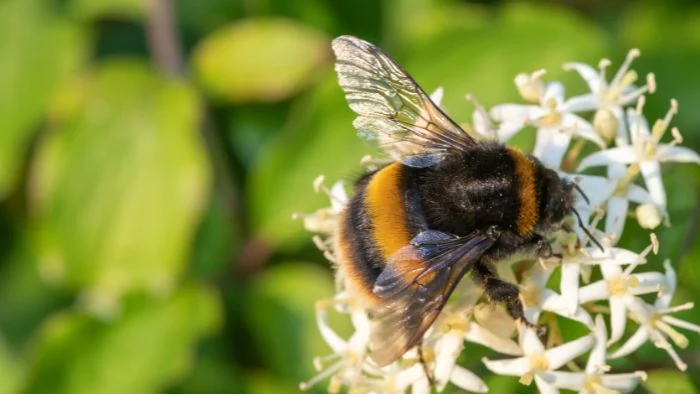
The Black-Tailed Bumblebee – Bombus Melanopygus Edwardsii
This small bumble bee is largely black in California. In other western states, it can have slightly different colors. This is one of the few bumble bees you will see in San Francisco. It seems to have some resilience to surviving in certain disturbed urban landscapes, where the natural vegetation has been heavily altered. This bee nests in the ground or structures and has a relatively typical bumble bee life strategy – queens over winter, start colonies, colonies grow, produce workers, expand, produce drones and queens, at the end of the season the young queens go and hide in secluded spaces, overwinter and emerge in spring and start the process again.
Other Smaller Funny Little Bees
I say this in the gentlest fashion. When I go and look at flowers, I find that a lot of little bees lurk around – if you look closely at a perennial basil plant, for instance, you will find, at peak sunlight, that there are many different types of bees working the flowers. Some of these are small little things the size of a little fly, others are big carpenter bees, bumble bees, and honeybees. The small funny little bees are too many and too complex to list here in detail. But just look at the flowers and when you see a smaller little insect, look and see if it is collecting pollen, and if it does this it is most likely a bee! Just enjoy it, and make sure to provide it with security – no poisons – and love. These little pollinators will keep our world going when we finally manage to destroy honeybees through our collective stupidity in pursuing a world where chemical treatments reduce biodiversity.
If you want to identify these little pollen-eating critters, I would suggest getting a guide such as this one. There are a lot of little bees. A lot.

Honey Bees In California – A Misunderstood Non-Native Bee Species
When it comes to California native bees identification methods, it is important to understand that the honeybee is not indigenous to the Americas. There have been two major introductions of honeybee races to the Americas. European honeybees were introduced during the early Colonial periods, and various improvement processes have seen additional European honeybee genetics introduced. The Buckfast bee was introduced into California in the mid 1900s and was very successful. This bee was of mixed European and African lineage, and rumors suggest that the Californian climate caused this bee to breed back to nearly pure African Genetics.
At the same time that this occurred, African bees that had been introduced in South America found their way north and entered parts of California. Fear and hype around these bees dubbed the “African Killer Bees” stopped people from seeing the benefits of these hard-working, disease-resistant bees. In Africa, African bee races produce huge honey crops in desolate environments where European bees will struggle to survive. With time, African bees will probably become a reliable source of commercial pollination, much like they provide in South America and Southern Africa.
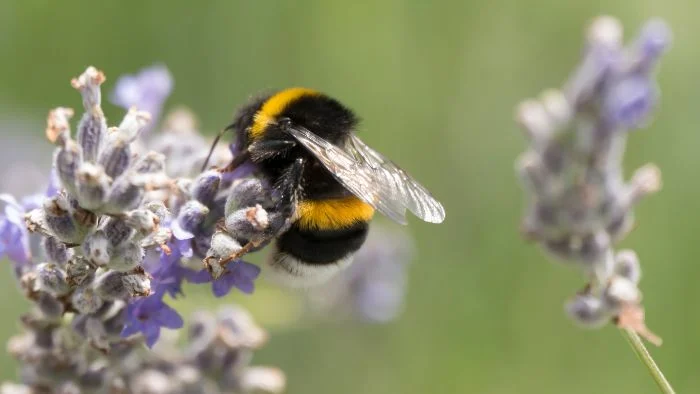
California Native Bees Identification
I hope this article has given you a nudge towards knowing the big, bad, and ugly (Apis mellifera in this case is not native) basic bee types of California. If you want to go down the rabbit hole of identifying bee species that are less obvious than the big carpenter and bumble bee species, I suggest the book listed here.

California Native Bees FAQs
1. What are native bees, and how do they differ from honeybees?
Native bees are the original pollinators that existed in California long before honeybees were introduced by European settlers. Unlike honeybees, which are not native to North America, native bees include species such as carpenter bees, mason bees, and bumblebees. These bees are often solitary and less likely to sting, playing a crucial role in pollination.
2. How can I identify Californian native bees in my garden?
Californian native bees vary in size, color, and behavior. Large carpenter bees (e.g., Xylocopa californica) are pitch black with a slight greenish tint, while bumblebees like the Yellow-Faced Bumblebee (Bombus vosnesenskii) have yellow markings on their face. Observing these bees’ size, behavior, and nesting habits will help with identification.
3. Why are native bees important for California’s ecosystem?
Native bees are excellent pollinators for both wild plants and agricultural crops. Many native plants rely on specific native bees for successful pollination. By preserving native bee populations, you help maintain biodiversity and ensure that ecosystems remain healthy.
4. How can I encourage native bees to nest in my garden?
To attract native bees, provide suitable nesting habitats like mud, plant stems, or wooden structures for mason and carpenter bees. Avoid using pesticides, as they can harm these important pollinators. Native plants are also excellent for attracting native bees.
5. Are honeybees considered native to California?
No, honeybees (Apis mellifera) are not native to California or North America. They were introduced by European settlers. While they are valuable for commercial pollination, they can outcompete native bees for resources, making the preservation of native bee species even more important.
6. What are some common native bee species found in California?
California is home to a variety of native bees, including:
- Carpenter bees like Xylocopa californica
- Bumblebees such as the Yellow-Faced Bumblebee (Bombus vosnesenskii), the Western Bumblebee (Bombus occidentalis), and the Black-Tailed Bumblebee (Bombus melanopygus edwardsii). These bees can be identified by their distinct body sizes, colors, and nesting behaviors.
7. How can I differentiate between a native bee and a wasp?
Wasps tend to have narrow waists and smooth, shiny bodies, whereas bees are generally hairier to collect pollen. Native bees like carpenter bees are often larger and darker, while wasps are more aggressive and less likely to be seen collecting pollen.
8. What threats do native bees face in California?
Native bees are under threat due to habitat loss, pesticide use, and competition with non-native species such as honeybees. Climate change is also affecting their habitat, which is why creating bee-friendly spaces in gardens and urban areas is essential.
9. Can native bees sting, and are they aggressive?
Native bees are generally less aggressive than honeybees. Many, like mason and leafcutter bees, are solitary and unlikely to sting unless provoked. Bumblebees and carpenter bees may sting but are typically non-aggressive unless defending their nests.
10. How can I help protect California’s native bee populations?
To help protect native bees, plant native flowers, avoid using chemical pesticides, and provide nesting habitats. Educating yourself and others about the importance of native bees in local ecosystems also contributes to their conservation.

Dr. Garth A. Cambray is a Canadian/South African entrepreneur and beekeeper with 28 years of experience in apiculture and specializes in adding value to honey. His Ph.D. research developed a new advanced continuous fermentation method for making mead that has resulted in a number of companies globally being able to access markets for mead. His company, Makana Meadery, exports honey mead to the USA where it is available to discerning connoisseurs. He has also developed technologies to commercially manufacture organic honey vinegar in Zambia for export globally. He holds a few patents globally in the ethanol industry and believes in technology and knowledge transfer for human development and environmental sustainability. One of his proudest achievements is the fact that the wind farm he started at one of his old apiary sites has essentially made his hometown carbon neutral.

